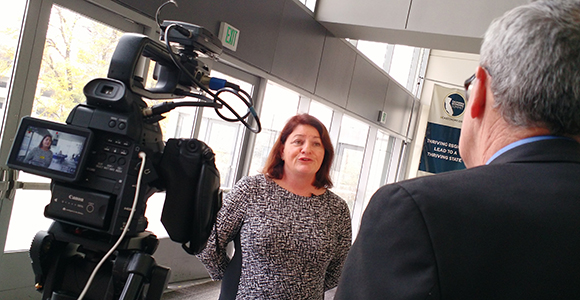
Senator Toni Atkins (D-San Diego) interviewed about California housing issues at the 2016 California Economic Summit in Sacramento. (Photo Credit: John Guenther/CA Fwd)
While leaders at the 2016 California Economic Summit this week explored ways to train and graduate more skilled and degreed workers, the challenge of providing enough water and housing to sustain that workforce also took top billing.
These were two of the big challenges addressed at the Summit, where more than 500 civic, business, and thought leaders gathered in Sacramento.
“Housing is the platform foundation for every possible success in California,” said State Senator Toni Atkins (D-San Diego). But, she added, “We’re moving into a crisis of housing affordability.”
McKinsey & Company’s Shannon Peloquin, co-author of a report on Closing California’s Housing Gap, framed the problem with some striking facts about the depth of the problem. “It’s now reached the point where it’s affecting everyone in low-income, but also 50 percent of middle-income families,” said Peloquin. “More than 50 percent of families are burdened by housing costs.”
The recession hit communities of color harder and minorities have lost 30 years of wealth gained in just three years, according to John Gamboa, president of California Community Builders.
“Our communities (of color) have been in a housing crisis forever,” said Gamboa. “It affects our community more because homeownership has been the avenue to create the middle class and wealth.”
California used to be able to build at a higher level, closer to 200,000 housing units in the 1980s, said Ben Metcalf, director of California's Department of Housing and Community Development.
“We have had the potential in the past,” said Metcalf. “We just need to figure out the solutions.”
To build more housing in the right places for more Californians, the Summit's Housing Action Plan for 2017 will take an “all of the above” approach to increase California's housing supply by expanding resources for subsidized housing, while also incentivizing the production of market-rate housing near jobs and transit.
The Summit is striving toward the goal of adding one million more homes in the next decade. To get there, the Action Team will pursue fiscal incentives through legislation that will produce property tax incentives, program investments that promote affordability and regulatory incentives that reduce housing costs and accelerate development. The combined plan will be presented to the Legislature in the coming year.
And according to Atkins, “You’re going to see a lot of housing legislation, because we are in a housing crisis.”
Additionally, the housing team will also work on increased accountability that will strengthen planning and regulatory statues as well as improve approval and permitting rules.
With more housing, access to reliable sources of water to both residents and businesses becomes an even more vital element to California’s economic success. To that end, CA Fwd is working on the challenge of conserving, capturing and reusing one million more acre-feet of water each year over the next 10 years.
Wednesday’s discussion about California’s water issues focused on regional collaboration such as those under way in Sonoma County and the Santa Ana River Watershed, which have become models for a regional approach to water sustainability.
“One of the things we needed most is to understand what is the reasonable amount of water to use in our daily lives,” said panelist Martha Davis of the Inland Empire Utilities Agency. “What the state is doing is setting up standards that help inform us where the waste is and we can inform the public and business who are partners with us.”
In addition, the Summit's Working Landscapes Action Team’s ultimate goals are to make California’s water supply more reliable, reduce demand on the Delta and improve water quality, especially for communities with limited access to clean water. The team will use regional innovations to address the distinct water issues that exist in the state. The Summit will also encourage exploration of new and innovative financing and governance vehicles, such as Enhanced Infrastructure Financing Districts (EIFD), a tool being evaluated to revitalize a large section of the Los Angeles River.
The action plans that attendees sharpened at the Summit will be included in a comprehensive strategy for 2017, which will combine triple bottom line solutions to address the intertwined challenges of water, workforce, and housing to expand upward mobility for more Californians.
“Housing prices touch everyone,” said Denise Pinkston partner at TMG Partners. “We can't have a workforce pipeline if we don't have a place for them to live.”

